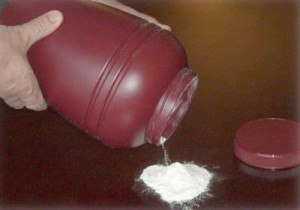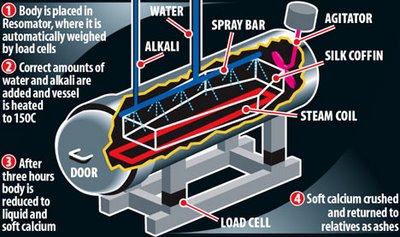
Resomation remains: ashes to ashes, dust to dust
We’re all going to die eventually, and after all our “green” efforts while living, wouldn’t it suck if our last earthy impact was less than environmentally friendly?
Enter “Resomation,” the “environmentally kinder alternative to burial and cremation.” And guess what, it’s a water-based process, so we can float out instead of being burnt out or covered up!
According to the website of the Scotland-based company, “instead of fire, Resomation uses a water and alkali based method to advance the natural process of decomposition. The Resomation process takes no longer than cremation and the funeral ceremony will be the same.” The term Resomation is derived from ‘Resoma’ which is Greek for “return of the human body.”

Illustration via spluch.blogspot.com
Among the environmental benefits are reduced energy usage, no mercury contamination and a process that’s an acceleration of natural decomposition. (It seems that mercury enters the cremation cycle through silver amalgam dental fillings. Who knew!)
And get this: a low carbon footprint! Your final passage will occur with fewer CO2 emissions than if you were cremated. Alas, like many of these “green” solutions, there is a tradeoff as I would imagine you’ll march out of this life with a bigger water footprint!
Via ecogeek, the process works something like this:
Within a tank called a resomator, the body is immersed in a 1:21 solution of potash lye and water. Gas-powered steam generators build up pressure within the tank as the temperature rises up to around 170 degrees Celsius. Thanks to the pressure (and despite what the general news media would have you think) there is no boiling, only a chemical reaction that completely liquefies everything but the bone ash in our bodies. When the tank is opened, only the bone ash and any implants or prosthetics the person had remain.
Ecogeek interviewed the company founder, Sandy Sullivan, and got the actual numbers:
…an average cycle in this tank of three hours will consume around 90 kWh, while a cremation will consume 250 kWh. According to Mr Sullivan, the total carbon footprint of a resomation is 18 times less than that of a cremation.

"Peace - Burial at sea" Joseph Mallord William Turner (1842)
This seems like a great idea to me, but frankly, more detail than I’d like. (I didn’t need to see a schematic drawing of a human chemical cooker.) My notions of passing on are more conceptual and romantic… like a burial at sea. Wouldn’t that be even greener? (We’d follow EPA rules that call for “flowers and wreaths consisting of materials that are readily decomposable in the marine environment.”)





